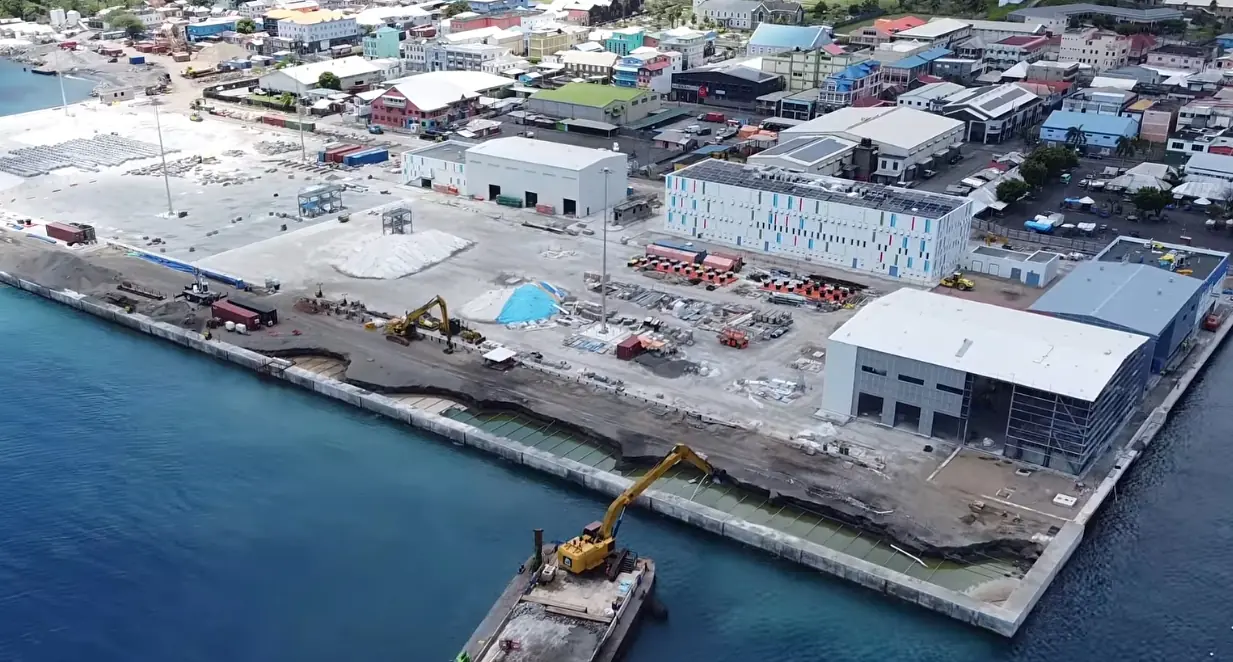The complete section adjacent to the Quay Wall at the new Kingstown Port is expected to experience a collapse, resulting in an increased visibility of water during the rectification process.
On Sunday, Lenski Douglas stated that the construction of the new Kingstown port involved the contractor placing reclamation material in the harbour before the quay wall was constructed. This prior placement of material has resulted in an excess of material on the outside, where vessels are required to berth.
Douglas indicated that the contractor was required to eliminate the surplus material on the exterior to achieve sufficient depth for the vessels to dock alongside. Materials were excavated to a depth of 12 meters below the water level.
“The depth is to ensure that you can accommodate the larger type vessels that are expected to visit without having any challenge in terms of them running aground. So, during that exercise, we realised that materials were being lost from the land side; obviously something went wrong. You had to investigate. When we investigated, we realised that what occurred is that between each king pile, there’s a sheet pile. And they typically do what you call clutch together. What has happened is that those clutches, for one reason or another, would have separated; 30% of the clutches would have separated. The material, therefore, is being lost through those separations.”
“It was determined that the only compromise on the wall is its retention ability. That’s why you see the material being lost, not the structural stability or otherwise. The fix that will be applied has three components, and it’s a standard fix. Doing it can be time-consuming and also challenging because you’re speaking of having to force now close those gaps that the material is escaping from. How do you do that? You’re going to be doing that by welding steel plates onto each king pile. so, spanning across where the sheet pile isn’t filled You’ve welded plates from one pile to the other. That then creates a cavity between the sheet pile and your welded plate, which you would then fill, which is the second step. Fill with concrete, then seal to prevent loss of reclamation material in the future. Once that seaside work is done, the third step begins.”
Douglas stated that applying the concrete to fill the cavity, thereby restoring the retention capability of the quay wall, represents the final stage and while you cannot control the initial loss of material through the declutching, as you do the repairs and excavate, one would expect additional loss.
“So, the public will see photos appearing to be worse. But what they see as being worse. For us? It’s actually the fix being applied. And there’s also another reason why the contractor has to excavate on the inside and make those holes bigger. The loss of material was true of the compacted fill. And it is possible that once that material is being lost, you can have cavities developing. So the surface can look good, but the cavities can develop. So, it is prudent that you collapse along that entire quay wall to be certain that you have no cavities. That’s the apron section, which is where the cranes and the containers would eventually land.”
Douglas said, A picture is worth a thousand words, and what the current picture shows is more than just holes.
“It shows the fact that the area remains stable because you have the equipment, the container workspace, you see platforms, and you see activity being done. You see vehicles driving along, and that would not be done if it were an unsafe, uncontrolled, erratic type of operation.”
“By the time you get to June thereabouts, and hopefully before, you will also see the compaction occurring from the side to the fish market and progressing down. And once that compaction is done, then you get back to your normal scheme of things, of putting down the subbase material, the cement-treated base material, and then you finish your pavement layer. Install your bollards, install the fenders and dock the ships’.
Douglas said the welding is being done by certified divers from a UK company with vast experience.
The executAccording to Douglas, the welding execution in the section where the large depression would have developed was about 16% complete at the last count.



